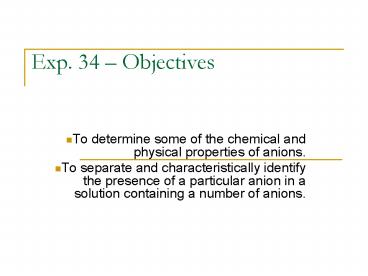Exp' 34 Objectives PowerPoint PPT Presentation
1 / 17
Title: Exp' 34 Objectives
1
Exp. 34 Objectives
- To determine some of the chemical and physical
properties of anions. - To separate and characteristically identify the
presence of a particular anion in a solution
containing a number of anions.
2
Exp. 34 Introduction
- Common anions in aqueous solution are either
single-atom ions such as Cl-, Br-, I- or
polyatomic anions usually containing oxygen such
as OH-, SO42-, CO32-, or PO43-. - In nature, the most common anions are the
chlorides, silicates, carbonates, phosphates,
sulfates, nitrates, aluminates, and their
combinations.
3
Exp. 34 Introduction
- Tests can be run to identify the presence of a
particular anion in a solution, but these tests
are subject to interference from other ions.
Therefore, the interfering ions must be
eliminated.
4
Exp. 34 Introduction
- Most common anions can be classified into 3
groups according to their chemical properties - Anions I Insoluble salts of barium ion in a
basic solution. SO42-, PO43-, CO32-. - Anions II Insoluble salts of silver ion in a
dilute HNO3 solution. Cl-, Br-, I-, S2-. - Anions III Soluble ions. NO3-.
5
Exp. 34 Introduction
- The separations and identifications that you will
be doing today are outlined in the flow diagram
on p. 390. Refer to this diagram as you run your
experiment and work on your report sheet. - Appendix G is also a useful reference for this
experiment.
6
Exp. 34 Introduction
- Sulfate Ion
- All sulfate salts are soluble (except those of
Sr2, Ba2, Hg2, Pb2). The addition of Ba2 to
an acidified solution containing SO42- produces
insoluble barium sulfate. - Ba2(aq) SO42-(aq) ? BaSO4(s)
7
Exp. 34 Introduction
- Phosphate Ion
- All phosphate salts are insoluble (except those
of the Group 1A cations and NH4). Like the
sulfate salt, the phosphate salt of barium forms
a white precipitate in basic solution. However,
Ba3(PO4)2 dissolves in an acidic solution, while
BaSO4 does not. - 3Ba2(aq) 2PO43-(aq) ? Ba3(PO4)2(s)
- ?
2H(aq) -
3Ba2(aq) 2HPO42-(aq)
8
Exp. 34 Introduction
- Phosphate Ion (contd)
- Ammonium molybdate added to an acidified solution
of the hydrogen phosphate ion precipitates yellow
ammonium phosphomolybdate, confirming the
presence of phosphate ion in the test solution. - HPO42-(aq) 12(NH4)2MoO4(aq) 23H(aq) ?
(NH4)3PO4(MoO3)12(s) 21NH4(aq) 12H2O(l) - The reactions of arsenate ion are identical to
PO43- and, if present, interfere with this test.
9
Exp. 34 Introduction
- Carbonate Ion
- All carbonate salts are insoluble (except those
of Group 1A cations and NH4. Acidification of a
solution containing carbonate ion produces
CO2(g) - CO32-(aq) 2H(aq) ? H2O(l) CO2(g)
10
Exp. 34 Introduction
- Carbonate Ion (contd)
- When CO2 comes in contact with a basic solution
containing Ca2, the carbonate ion re-forms and
reacts with the Ca2, forming a white
precipitate - CO2(g) 2OH-(aq) ? CO32-(aq) H2O(l)
- ?
Ca2(aq) -
CaCO3(s) - If SO42- is present, it will interfere with the
test, producing SO2(g) and insoluble calcium
sulfite.
11
Exp. 34 Introduction
- Sulfide Ion
- The sulfide ion exists only in basic solutions.
Most sulfide ions are insoluble, including CuS.
When Cu2 is added to a solution containing
sulfide ion, a black precipitate of copper (II)
sulfide, CuS, forms, confirming the presence of
sulfide ion in the solution - Cu2(aq) S2-(aq) ? CuS(s)
12
Exp. 34 Introduction
- Halide Ions
- The salts of Cl-, Br-, and I- are soluble with
the exception of the Ag, Pb2, and Hg2 halides.
- If you simply add Ag to a solution of halides,
all silver halides will precipitate out. - In order to identify halide ions, we use ease of
oxidation I- Br- Cl- - ease of oxidation
13
Exp. 34 Introduction
- Halides (contd)
- A weak oxidizing agent oxidizes only the I-.
- In this experiment, Fe3 oxidizes I- to purple I2
which is soluble in toluene, which is immiscible
with water - 2Fe3(aq) 2I-(aq) ? 2Fe2(aq) I2(toluene)
14
Exp. 34 Introduction
- Halides (contd)
- Acidic KMnO4 oxidizes Br- to brown Br2 which is
also soluble in toluene - 2MnO4-(aq) 10Br-(aq) 16H(aq) ? 2Mn2(aq)
5Br2(toluene) 8H2O(l) - A dilute KMnO4 solution is used so that the Cl-
wont be oxidized.
15
Exp. 34 Introduction
- We then precipitate the Cl- with Ag
- Cl-(aq) Ag(aq) ? AgCl(s)
- As an additional confirmation, we dissolve the
AgCl in NH3 - AgCl(s) 2NH3(aq) ? Ag(NH3)2(aq) Cl-(aq)
16
Exp. 34 Procedural Notes
- Part A.1. Solution becomes very basic after 1
drop of NH3. Add 4-6 drops of Ba(NO3)2. - Part C. 15-20 minutes.
- Part D.1. Solution is corrosive! Add 8-11
drops of Ba(NO3)2. - Part E. 2 Drops of HNO3. May take a couple of
minutes to form ppt. - Part G.2. Do not do.
- Part I. - Omit
17
Exp. 34 Report Sheet
- Questions 3 and 4

